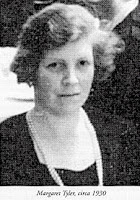Julia Green and Sir John Weir both wrote biographical sketches of Margaret Tyler on the occasion of her death. They are reprinted here. Julia Green wrote of Tyler in the Journal of the American Institute of Homeopathy in 1962: “I think you all know something about this wonderful woman. The only child of a Peer in England, she became heir to much money at her father’s death. Being by that time in the practice of the homeopathy that she loved and wished to share, she picked perhaps a dozen young men and sent them to Chicago where Dr. J. T. Kent was teaching students in the best of homeopathy. These youths took their knowledge back to England and scattered through the country. The best known one is still living, Sir John Weir, physician to the royal family in London.” Sir John Weir writes a much lengthier article in The British Homeopathic Journal.
“With the passing of Dr. Margaret L. Tyler Homeopathy loses one of its outstanding personalities. She owed much to her parents, Sir Henry and Lady Tyler, who early on imbued her with the family characteristics of enterprise, thoroughness, and selflessness in service for others. Dr. Tyler’s homeopathic interest was early aroused by her mother’s skillful care of a large family. She took up the study of medicine in order to be able to help the poor patients at the London Homeopathic Hospital. There she worked for over forty years, in various departments, and was appointed to the Staff of the hospital in 1914. When due to retire a special appointment was made to retain her services, and she carried on to the end.”
The out-patient department, she declared, was the happiest place in her life, and she always looked forward to meeting her friends, as she termed the patients. Her clinic was large, and the patients appreciated her devotion to them.
She was a great teacher and many sought the post of clinical assistant with her, to get wise and refreshing help. She could draw deeply from a storehouse of homeopathic knowledge… She read a drug each night before retiring, in different books to feel the spirit of the remedy…
About 1907 her great anxiety was for the future supply of homeopathic physicians, as there was no definite post-graduate training, though much had been done by individuals. She was a great believer of going to the fountainhead, as she termed Hahnemann, and feared that much of the homeopathic practice was getting away from her ideal. She then, with her mother, instituted the Sir Henry Tyler Scholarship Fund to help doctors go to the U.S. A. to study under Dr. James Tyler Kent, a keen Hahnemannian in practice. This created a stir and much controversy, but Dr. Tyler carried on with her efforts, and many of the physicians of today studied under Dr. Kent between 1908 and 1913.
Dr. Tyler remained a learner all her life, hence her freshness of outlook, as shown in her many pamphlets on the various subjects of Homeopathy. She loved to dip into the past, and to recall the triumphs of the early believers.
We owe much to her writings. The study of Drosera awoke a new and deep appreciation of this drug, and for the last few years she had developed an interest in the nosodes, finding confidence by her results in the exhibition of these remedies. Indeed, she often said that her usefulness as a physician was greatly enhanced by her knowledge of these apt-to-be-forgotten remedies…
Her Drug Pictures of homeopathic remedies, culled from every possible source, are a storehouse of information; she consulted freely and deeply with the giants of the past; her references were meticulous, and she went to great pains for verification. She felt that the information was essential for others, and that was enough to stimulate her to further endeavor.
The Correspondence Course on Homeopathy, for those who could not attend lectures, has been of great help to many… Dr. Tyler spent years over its production.
But perhaps her greatest field of usefulness was through her Editorship of the journal Homeopathy, for the eleven years from 1932 to 1942. Its influence was world-wide, and has been described by a contemporary as “one of the best journals of pure Homeopathy published.” One American Society took it as a text-book for its studies…
Behind the physician was a woman who was deeply imbued with the ultimate religious value of life. In that spirit she did her work. She was trusted and respected by many, for her fine character, personal integrity, and complete lack of all selfish ambition. One of her admirers has written: “I am convinced that Margaret Tyler will be recognized as a very great woman and homeopathic pioneer in the future. She will rank with that good Victorian company in which we honour the names of the many richly endowed adventurous souls who saw the future in the instant and clung to their faith, and, for right of wrong, brooked no interference in their concept.”
Despite her failing health, she worked to the very end, and died in service. It is typical that one of her last quotations was: “At the end of life we shall not be asked how much pleasure we have had in it, but how much of service we gave in it; not how full of success, but how full of sacrifice; not how happy we were, but how helpful we were.”
Dr. Tyler’s memory and influence will live in the hearts of many. She died on 21 June, 1943, having “served her generation, by the will of God.”

– S. Nielsen,